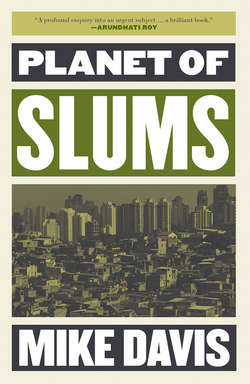Читать книгу Planet of Slums - Mike Davis - Страница 16
На сайте Литреса книга снята с продажи.
3. Invisible Renters
ОглавлениеAs a rule of thumb, both the popular and scholarly literatures on informal housing tend to romanticize squatters while ignoring renters. As World Bank researchers recently acknowledged, “remarkably little research has been done on low-income rental markets.”83 Landlordism is in fact a fundamental and divisive social relation in slum life worldwide. It is the principal way in which urban poor people can monetize their equity (formal or informal), but often in an exploitative relationship to even poorer people. The commodification of informal housing has included the rapid growth of distinctive rental subsectors: infill developments in older shantytowns, or multifamily constructions in pirate subdivisions. To be sure, most of the urban poor in West Africa have always rented from landlords, as have a majority of residents in Dhaka and some other Asian cities (in Bangkok two-thirds of “squatters” actually rent the land they build their shacks upon).84 Renting has also become far more common than usually recognized in the peripheries of Latin American, Middle Eastern and South African cities. In Cairo, for example, the more advantaged poor buy pirated land from farmers, while the less advantaged squat on municipal land; the poorest of the poor, however, rent from the squatters.85 Likewise, as urban geographer Alan Gilbert observed of Latin America in 1993, the “vast majority of new rental housing is located in the consolidated self-help periphery rather than in the centre of the city.”86
Mexico City is an important case in point. Despite a Model Law of the colonias proletarias which sought to ban absentee ownership, “poaching,” and speculation in low-income housing, the Lopez Portillo government (1976–82) allowed slum-dwellers to sell their property at market rates. One result of this reform has been the middle-class gentrification of some formerly poor colonias in good locations; another has been the proliferation of petty landlordism. As sociologist Susan Eckstein discovered in her 1987 return to the colonia that she had first studied fifteen years earlier, some 25 to 50 percent of the original squatters had built small, 2-to-15-family vecindades which they then rented to poorer newcomers. “There is, in essence,” she wrote, “a twotiered housing market, reflecting socioeconomic differences among colonos.” She also found “a ‘downward’ socioeconomic leveling of the population since I was last there…. The poorer tenant stratum has increased in size.” Although some older residents had thrived as landlords, the newer renters had far less hope of socioeconomic mobility than the earlier generation, and the colonia as a whole was no longer a “slum of hope.”87
Renters, indeed, are usually the most invisible and powerless of slum-dwellers. In the face of redevelopment and eviction, they are typically ineligible for compensation or resettlement. Unlike tenement-dwellers in early-twentieth-century Berlin or New York, moreover, who shared a closeknit solidarity vis-à-vis their slumlords, today’s slum renters typically lack the power to organize tenants’ organizations or mount rent strikes. As two leading housing researchers explain: “Tenants are scattered throughout irregular settlements with a wide range of informal rental arrangements, and they are often unable to organize as a pressure group to protect themselves.”88
Large peripheral slums, especially in Africa, are usually complex quiltworks of kin networks, tenure systems, and tenant relationships. Diana Lee-Smith, one of the founders of Nairobi’s Mazingira Institute, has closely studied Korogocho, a huge slum on the eastern edge of the city. Korogocho includes seven villages offering a menu of different housing and rental types. The most wretched village, Grogan, consists of one-room cardboard shacks and is largely populated by female-headed households evicted from an older shantytown near the city center. Barracks-like Githaa, on the other hand, “is an entirely speculative village, built by entrepreneurs for rent,” despite the fact that the land is publicly owned. Nearby Dandora is a sites-and-services scheme where half the owners are now absentee landlords. Lee-Smith emphasizes that petty landlordship and subletting are major wealth strategies of the poor, and that homeowners quickly become exploiters of even more impoverished people. Despite the persistent heroic image of the squatter as self-builder and owner-occupier, the reality in Korogocho and other Nairobi slums is the irresistible increase in tenancy and petty exploitation.89
Soweto, having grown from a suburb to a satellite city of almost 2 million, likewise demonstrates a broad spectrum of housing statuses. Two-thirds of its residents live either in formal-sector private homes (the professional middle class) or, most commonly, council homes (the traditional working classes); in the backyards of the latter, residents have illegally constructed shacks that are rented to younger families or single adults. Even poorer people, including rural immigrants, either room in hostels or squat on the outskirts of Soweto. Johannesburg’s other famous slum from the high Apartheid era, Alexandra, is more destitute and has fewer formal-sector homes. Most of the population are squatters, renters, or hostel-dwellers.90
This diversity of property rights and housing forms in large African and Latin American slums, not surprisingly, generates very different perceptions of interest. As geographer Peter Ward points out in the case of Mexico City, “one’s ideological perspective is likely to be shaped by one’s housing status:”
the hetereogeneity of irregular settlement … undermines collective response by dividing settlements on the basis of mode of land acquisition, the “stage” of consolidation, the servicing priorities of residents, community leadership structures, social classes, and above all tenure relations (owners versus sharers versus renters). These tenure splits multiply still further the constituencies into which people fall or may be divided. … Renters, harassed squatters, displaced downtown tenants are likely to be more radical and disposed to anti-government demonstrations than are those who have, in effect, been bought-off by the government through successive housing policies.91
